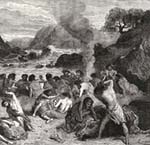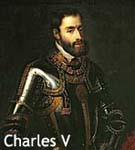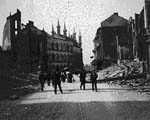 Neolithic peoples arrived first. Then by 1750 BC the first signs of Bronze Age activity began, and around 500 BC Celtic tribes started settling in the area. These early inhabitants became known as the Belgae (a name from which modern-day Belgium comes).
Neolithic peoples arrived first. Then by 1750 BC the first signs of Bronze Age activity began, and around 500 BC Celtic tribes started settling in the area. These early inhabitants became known as the Belgae (a name from which modern-day Belgium comes).Some 450 years later the armies of Julius Caesar invaded the Belgae, and under his rule Belgium thrived as a province of Rome.
After the collapse of the Roman Empire around 400 AD, Germanic tribes swarmed Gallia and the Belgae became part of the Merovingian Dynasty ruled by Clovis I. Although a short-lived dynasty, Clovis I managed to convert the area into Christianity.
After the Moorish invasion from Spain around 752 AD, King Charlemagne reigned over a large chunk of Europe,including the area of present-day Belgium.
However, after the defeat of the Vikings in the 8th century, the lands were split under the Treaty of Verdun and reconvened into the Merovinigian and Carolingian dynasties, before ultimately being divided into France and the Holy Roman Empire.
As the Holy Roman Empire began to lose control in the 11th and 12th centuries, present-day Belgium found itself divided into seven independent states.
Many gradual shifts of power occurred over the years, and by year 1433, most of Belgium was ruled by Philip the Good as part of the Duchy of Burgundy. During this rule, many cities in Belgium, including Ypres, Ghent, Bruges, Brussels and Antwerp played the role as major Europeancenters for commerce, industry and art.
 The Pragmatic Sanction of 1549 issued by Charles V separated the empire from France, and the Seventeen Provinces were established.
The Pragmatic Sanction of 1549 issued by Charles V separated the empire from France, and the Seventeen Provinces were established.A revolt in 1567 consequently pushed those provinces into Spanishrule, and in the 1700's they became subject to the Austrian Habsburgs, then to France, and finally by 1815, to the Kingdom of the Netherlands. By 1830 a revolt dissolved the final union, and Belgium was considered an independent country.
Now a predominately Catholic and French speaking country, the new nation prospered industrially, and became the railway center of the region after Leopold I built the first railway in continental Europe between Brussels and Mechelen, France.
In 1914, as World War I began, Germany tried to take control of Paris by invading Belgium, in an attempt to catch the French off guard by going through neutral countries. Allied with Britain pre-war, the two countries, along withFrance, were able to stop the German progression.
Even still, the Germans remained in Belgium, and ruled through a General Governorate. Hundreds of thousands of Belgians consequently lost their lives, and a considerable amount came from Flanders - which is known for its vast Poppy fields, and the flowers have since become an emblem of human life lost in that tragic war.All was not completely lost in Belgium, as during the war it overtook Ruanda-Urundi (present-day Rwanda and Burundi) from Germany, as well as several other Africanterritories, and after the war annexed the Prussian districts of Eupen and Malmedy.
 In 1939, as Germany invadedPoland at the start of World War II, the Belgian government announced its neutrality. Not at all deterred, Germany began their infiltration of the country on May 10, 1940, sparking the Battle of Belgium. Unfortunately for the Belgians, their King surrendered eighteen days later.
In 1939, as Germany invadedPoland at the start of World War II, the Belgian government announced its neutrality. Not at all deterred, Germany began their infiltration of the country on May 10, 1940, sparking the Battle of Belgium. Unfortunately for the Belgians, their King surrendered eighteen days later.In late 1944, Belgium was liberated by the Allied Forces ofBritain, Canada and the US. It was at this time that the Second British Army took control of Antwerp, and the First Canadian Army used the area as well to conduct combat operations.
Well, Germany didn't like the idea of the Allies using the port to bring new materials to shore, and dropped thousands of missiles onto the city. Although the city of Antwerp was battered and bruised, the port remained intact.
Post-war the government erased Belgium's debts. Naturally this jump started the economy, and amongst many rebuildings around the country, this was the time that Belgium's well-known highway system was constructed. In fact, the streetlights make the roads easily seen from space at night.
In 1960, Belgium played an ambiguous role during the Congo crises, which ultimately lead to the independence of Congo. Two years later Ruanda-Urundi followed with their own independence.
The 1970's through the 1980's saw the rise of the federal state in Belgium, as the country moved forward to find solutions to alleviate the tension between different sides of the Belgian population, particularly the two main Dutch and French language communities.
French-speaking Wallonia and Dutch-speaking Flanders were at the forefront of this language war. This tension pushed Belgium from a unitary state into a federal state with communities, regions and language areas, and to this day it remains a matter of great debate as reforms are still being made.
History was made in 1999 as elections were held for government officials, and for the first time since 1958 Belgium had a government that did not include the Christian's People Party.
 These days, modern Belgium is a self-sufficient, industrialized nation, and ishome base for NATO and the European Union (EU). In 1999 the Euro was introduced, replacing the Belgian franc. Then in 2003 the country became only the second ever to legalize same-sex marriages.
These days, modern Belgium is a self-sufficient, industrialized nation, and ishome base for NATO and the European Union (EU). In 1999 the Euro was introduced, replacing the Belgian franc. Then in 2003 the country became only the second ever to legalize same-sex marriages. One of Europe's great destinations, Belgium is known for its art, cathedrals, medieval cities and castles, fine chocolates, beers, gourmet foods and friendly, hospitable people.
Travelers to Belgium can't get enough of Bruges, a beautiful Medieval city that is sometimes called the "Venice of the North."
The same is true for Brussels, the stylish capital city, known for a variety of architecture, fashion, food and nightlife. The city's main attractions include the UNESCO World Heritage Site - the Grand Place - and the bronzed fountain Manneken Pis.
No comments:
Post a Comment